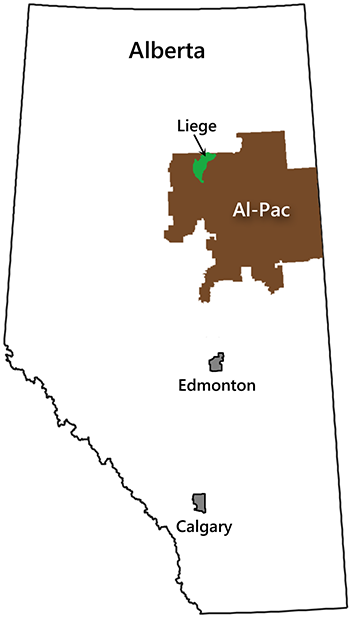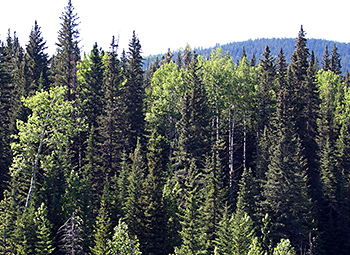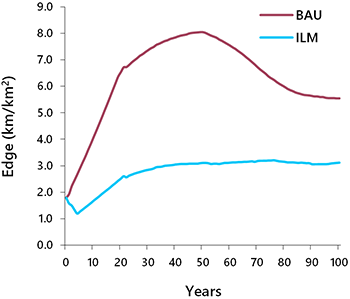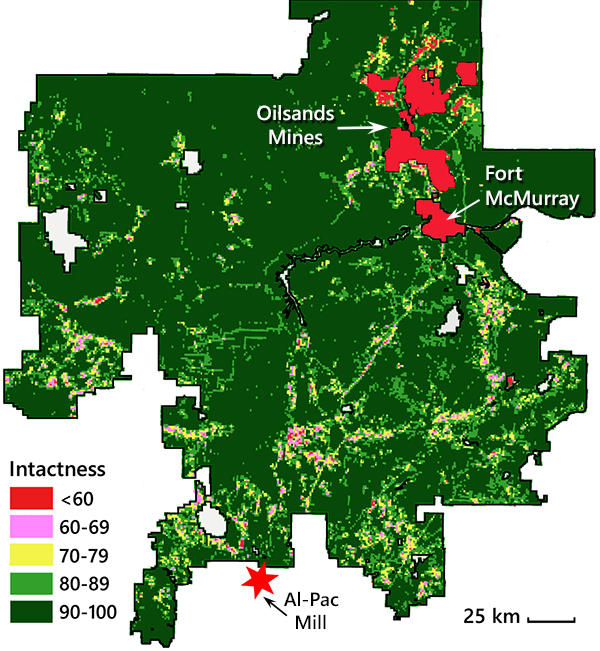Case Study 1: Ecosystem Management
Background
This first case study recounts the development and implementation of ecosystem management by Alberta-Pacific Forest Industries (Al-Pac) in northeast Alberta.
The origins of this case study trace back to the late 1980s. The Alberta government was searching for ways to diversify the provincial economy, and forestry was identified as one of the main sectors for expansion. Pulping technology had advanced sufficiently by the 1980s to enable the cost-effective pulping of aspen. Moreover, pulp prices had risen to the point where building new plants was economically viable (Pratt and Urquhart 1994).
Operating under the assumption that there was a limited window of opportunity before pulp prices would again decline, the government acted quickly. In 1987, without public consultation or environmental study, it leased timberlands the size of Great Britain and negotiated the development of a dozen major wood processing facilities, including five new pulp mills. The bulk of this expansion occurred in northern Alberta, where vast tracts of forest were brought into industrial production for the first time.

The largest of the new forest management areas (FMAs) was acquired by Al-Pac, which was owned by a Japanese conglomerate. The FMA was 61,000 km2, comprising almost 10% of the province (Fig. 11.1). To process all the new wood, Al-Pac proposed to build the world’s largest single-line kraft pulp mill, supported by government loan guarantees (Pratt and Urquhart 1994).
What the government and Al-Pac failed to realize was that the social landscape was shifting beneath them. As we saw in Chapter 2, by the late 1980s, a societal tipping point had been reached, and the rules for managing public forests were being rewritten across the country. Al-Pac, as the company behind the largest of the new projects, became the focal point of public discontent and was targeted with massive and protracted protests.
The Alberta government refused to back down, and the mill was eventually constructed and began operations in 1993. Al-Pac emerged from its near-death experience as a unique entity. Simply put, Al-Pac went “green.” Whereas existing companies and the government clung to conventional sustained-yield forestry, Al-Pac became a champion of new ecosystem-based approaches, turning its FMA into a research laboratory and proving ground for new ideas. It also implemented a chlorine-free approach to pulp production.
Leading Al-Pac’s new approach to forest management was an internal team of biologists and foresters. This group imported ecosystem management concepts from the US Pacific Northwest and then adapted them to Alberta’s forests with the help of ecological consultants and academic scientists.
Our examination of Al-Pac’s approach to ecosystem management will focus on the first decade of the company’s operations, which is when the ecosystem management framework was developed and when most of the key decisions were made. Any significant changes that have occurred since that time will be noted.
The Natural Disturbance Model
Al-Pac’s approach to ecosystem management centred on maintaining ecosystem attributes within the natural range of variability (NRV) through application of the natural disturbance model (see Chapter 7). In contrast to the Pacific Northwest, where ecosystem management led to a large decrease in the rate of harvest, Al-Pac intended to harvest at a conventional rate (and was required to do so under the terms of its lease). Working in Al-Pac’s favour, the company had considerable operational flexibility because the forest had never been harvested.

In its application of the natural disturbance model, Al-Pac focused on four main attributes: forest composition, stand structure, landscape pattern, and age structure (Al-Pac 2007). The objective with respect to forest composition was to maintain the existing distribution of stand types. This required changes to the way that mixedwood stands, composed of aspen and spruce, were managed (Fig. 11.2). Under conventional practice, mixedwood stands were regenerated to either pure aspen or pure white spruce after harvest. This unmixing process progressively changed the composition of the forest (Hobson and Bayne 2000).
Al-Pac’s solution was to implement an integrated approach to harvest planning referred to as “mixedwood management” (Lieffers and Beck 1994). The basic idea was to allow stands to regenerate as mixed stands and then harvest them twice: first to remove the fast-growing aspen—being careful to protect the spruce understory—and then later to remove the spruce, once it had matured. Because this approach was new, many knowledge gaps had to be addressed concerning growth and yield patterns, silvicultural techniques, and harvesting practices.
To implement mixedwood management, Al-Pac had to gain the support of several smaller lumber companies, referred to as quota holders. These companies had been awarded rights to most of the coniferous timber volume within the Al-Pac FMA (Al-Pac used mainly aspen in its mill). Because of their small size, quota holders were not on the public’s radar and had experienced little pressure to adopt progressive practices. Motivating them to participate in mixedwood management was not easy, as they perceived risk with little reward. In the end, a decision was made to implement mixedwood management on a trial basis, on selected management units. Eventually, in 2010, these practices were extended across the entire FMA, in response to new forestry regulations.
At the stand level, Al-Pac’s objective was to make harvest blocks as similar as possible to post-fire stands in terms of structure, size, and shape. Instead of the conventional practice of cutting square harvest blocks of uniform size (Fig. 5.10), Al-Pac’s harvest blocks followed natural stand contours. Also, rather than piling and burning logging debris, as was common practice, logging debris was scattered over the site. This step had to be rescinded in later years because the government believed that the retention of debris created an increased risk of fire.
To mimic fire skips (patches of unburned forest), clumps of live trees were retained within the harvest blocks (Fig. 7.8). Fire skips vary in size and shape because of the complexities of fire behaviour. Within the boundaries of a large fire, some stands may be virtually untouched whereas others may be completely burned. A study of eight large fires within the Al-Pac FMA found that, on average, 13% of small mixedwood stands (<10 ha) and 33% of large mixedwood stands (≥10 ha) remained as unburned patches (Smyth et al. 2005). Constrained by mill requirements, Al-Pac chose 5% as its live tree retention target—substantially below NRV but substantially greater than conventional practice (i.e., zero). Quota holders would only agree to a 1% retention target for their stands, though in later years the government required them to adopt a 3% target.
At the landscape scale, Al-Pac sought to replicate the broad spatial patterns created by fires. The challenge was that harvest block size could not exceed 500 ha because of public opposition to large clearings. This was far smaller than the large fires responsible for most of the area burned. Al-Pac’s solution was to implement an aggregated harvest system that focused harvesting in large “disturbance units” over a 10–20 year period (Carlson and Kurz 2007). Over time, individual harvest blocks would coalesce into large areas of young forest, approximating the effect of a large fire.
For logistical reasons, and because of uncertainty over social acceptance, Al-Pac limited the size of disturbance units to between 1,000 and 30,000 ha. This represents a subset of NRV. Historically, fires less than 1,000 ha accounted for 6% of the area burned in the FMA, and fires greater than 30,000 ha accounted for 41% of the area burned (Al-Pac 2007). Nevertheless, it is substantially closer to NRV than conventional practice, which generates very small patches across the entire management area.
With regard to the age structure of the forest, Al-Pac’s emphasis was on retaining old-growth stands, which were most at risk from forestry. Conventionally, older stands were harvested first, to avoid timber losses to fire or senescence. The long-term outcome was a truncated age distribution, with no stands older than the optimum age for harvesting (see Fig. 5.9). In contrast, Al-Pac sought to maintain at least 75% of natural levels of old-growth, in perpetuity (Al-Pac 2007).
The challenge was that the natural amount of old-growth was difficult to determine. Al-Pac believed that the existing amount of old-growth on the FMA was not representative of the long-term NRV. An unusual spike in burning had occurred at the turn of the twentieth century, and fire suppression had been practiced since the late 1970s, creating a larger than normal cohort of older stands in the 1990s. As an alternative, Al-Pac derived the NRV of old-growth from estimates of the natural rate of burning. The problem here was that expert opinion about fire occurrence on the FMA was divided. Estimates of the natural rate of burning ranged from 0.4% to 2.2% of the FMA per year—a fivefold difference (Cumming et al. 2000). Al-Pac selected an intermediate value of 1.3% and then used a timber supply model to predict the expected long-term average amount of old-growth by stand type (Fig. 11.3).

The modelled estimates of NRV were substantially different than the existing amount of old-growth on the FMA. In particular, the predicted mean for jack pine was three times higher than existing amounts, and the predicted mean for white spruce was almost three times lower than existing amounts (Fig. 11.3). The practical implication was that the majority of the existing old-growth white spruce on the FMA, which was harvested by the quota holders, was destined to be liquidated on the basis of Al-Pac’s NRV targets. In light of the uncertainties associated with fire modelling, and the large discrepancy between modelled and existing amounts of old-growth, this was a high-risk strategy. Al-Pac has since done additional fire modelling, but the old-growth NRV estimates have not changed significantly (Al-Pac 2015).
Another shortcoming of Al-Pac’s timber modelling approach was that, following conventional practice in Alberta, it did not take future fires into account. The philosophy was that harvest levels could be adjusted later to accommodate fire losses. The concern with this approach is that future timber shortfalls may lead to increased old-growth harvesting at a later date.
The Triad Approach
The second pillar of Al-Pac’s implementation of ecosystem management was the triad approach (see Chapter 7). The three zones of the triad included a sustainable forest management zone (most of the FMA), an unharvested ecological benchmark zone, and an intensive management zone. The site selected as the benchmark area was the 1,200 km2 Liege River watershed in the northwest corner of the FMA (Fig. 11.1). This area was generally representative of the FMA and, notably, had not yet been allocated to either coniferous quota holders or the oil and gas sector. It was therefore relatively pristine and unencumbered.
For the intensive management zone, Al-Pac implemented an agroforestry program on privately owned lands immediately south of the FMA. In addition, the company instituted growth trials of fast-growing hybrid poplar species near the mill site (also on private land). The area of oil sands mining, in the central part of the FMA, was also considered an intensive management zone.
A critical shortcoming of Al-Pac’s triad approach was that the company had no authority to enforce protection of the benchmark area it had selected, other than to curtail its own harvesting. Al-Pac lobbied the government to formally protect the site, but these efforts were not well received. Many within the government had a hard time understanding why Al-Pac would refrain from logging the forest it had just been allocated. Furthermore, even though quota holders and the oil and gas sector were not active in the Liege, they reacted negatively to the prospect of protection because it foreclosed future resource development options. The environmental community, for their part, supported the Liege, but only half-heartedly. The Liege had never been identified as a provincial priority, and the attention of environmental groups was focused elsewhere at the time.
In the end, raising the profile of the Liege watershed resulted not in its protection, but in its rapid leasing for oil and gas development. Al-Pac eventually abandoned it as a potential benchmark. It would take until 2018 for a large protected area to finally be established within the FMA, through a government-led land-use planning initiative (see Case Study 2). As for Al-Pac’s experiment with hybrid poplar plantations, this initiative was abandoned in the 2010s for economic reasons.
Integrated Landscape Management
The Al-Pac FMA was a busy landscape in the early 1990s, home not only to Al-Pac, but also to oil sands companies, conventional oil and gas companies, coniferous quota holders, peat miners, and gravel miners. Collectively, the oil and gas sector cleared nearly the same amount of forest each year as Al-Pac (Al-Pac 2007). Yet these companies were not required to reforest the areas they disturbed—most sites were simply replanted to grass. Clearly, Al-Pac’s vision of maintaining natural forest structures and patterns could not be realized without the support and participation of the other companies operating within the FMA. Thus, integrated landscape management became the third pillar of Al-Pac’s implementation of ecosystem management.

Al-Pac’s first step was to fully characterize the problem that needed to be solved. To do this, it enlisted the services of Brad Stelfox, an ecological consultant who had developed the ALCES cumulative effects model (www.alces.ca). ALCES was a bookkeeping model that tracked the state of a landscape as it evolved in response to disturbances (both anthropogenic and natural), as well as reforestation and succession. Using ALCES, Al-Pac showed how small disturbances from multiple operators would accumulate and fundamentally transform the FMA over the coming century. It also demonstrated how this industrial footprint could be substantially reduced through integrated planning (Fig. 11.4).
The second and harder step was to convince the other operators to cooperate. The coniferous quota holders were willing to have Al-Pac undertake joint harvest planning as long as their timber volume was maintained. But the oil and gas sector was not inclined to accede control of its planning to a forestry company. Moreover, these companies had never been held accountable for their impacts on the forest, and the concept of maintaining ecosystem integrity was unfamiliar to them. ALCES model projections and moral suasion were helpful in changing attitudes, but only to a point. What Al-Pac needed was support from the government, but this was not forthcoming until the late 2000s (see Case Study 2).
In the absence of other options, Al-Pac pursued its integrated planning agenda through ad hoc company-to-company initiatives that could be presented as win-win solutions. One of the first projects was with Gulf Canada (now ConocoPhillips) on its Surmont oil sands development. Through joint planning of access roads, and by focusing harvesting in areas that would later be used for oil installations, the project minimized forest clearing, realized a 47% reduction in roads, and achieved more than $3 million in joint cost savings (Demulder and Thorp 2007). This set the stage for engagement with other oil sands companies. Al-Pac also encouraged seismic exploration companies to reduce the width of seismic lines by rebating their timber damage fees if they applied best practices (Moore et al. 2005). This led to a rapid reduction in the width of lines—from 5–6 m down to 2.5 m—and it showed how quickly and effectively industry could respond when motivated.
Decision Making
Two levels of conservation decision making can be discerned in this case study. At the top level was Al-Pac’s corporate decision to pursue leading-edge forestry practices through the application of ecosystem management. This can be characterized as a risk-management strategy, motivated by the strong opposition the company encountered at the time of its establishment. Rather than remain a lightning rod for public discontent about forestry, executives decided that the company would fare better in the long run by becoming a leader in progressive forestry practices and mill operations.
The second level of conservation decision making concerned the myriad of operational decisions required to implement ecosystem management. Decision making at this level was led by the company’s ecological team, composed of biologists and foresters. The working objective was to maintain forest attributes as close to NRV as possible, while accommodating mill requirements and other social objectives.
Initial efforts were focused on research. To maintain forest attributes within NRV, Al-Pac had to first determine what the NRV was. It also needed to understand how harvesting differed from natural disturbances and which differences were most important to biodiversity. Some research was done internally; however, Al-Pac also developed collaborative relationships with university researchers, leading to a period of intense study of Alberta’s boreal forest. Hundreds of peer-reviewed studies involving the FMA were eventually published.
Al-Pac also engaged in the social aspects of conservation decision making. Initially, this entailed broad outreach efforts to raise awareness of ecosystem management and its benefits. Al-Pac also cultivated allies within the government, industry, academia, and stakeholder groups to help it advance its ecological vision and overcome resistance to change. Eventually, Al-Pac began to make the trade-off decisions that would define its version of ecosystem management. For the most part, the ecological team made these decisions internally, though it consulted extensively with other parties, both formally and informally. Mill requirements for profitability were taken as fixed constraints.
The team approached conflicts between conservation objectives and other social objectives as problems to be solved, to the greatest extent possible. Thus, considerable effort was devoted to the development of innovative solutions, rather than simply choosing from among existing approaches. It would ultimately take more than a decade for the core components and targets related to ecosystem management to be determined, and further refinement would occur in later years. Stretched out as it was, the process bore little resemblance to structured decision making. However, the main components (objectives, indicators, alternatives, trade-off decisions, and learning) were all present.
Analysis and Conclusions
This case study illustrates that conservation on public lands does not necessarily follow a linear path from public values to government policy to implementation measures. In this case, conservation was advanced through the direct influence of the public on a specific forestry company. The provincial government was more of a reluctant follower than a leader of conservation.
This example also illustrates the limitations of direct public action. The public certainly has the power to effect change, but it cannot grapple with details and complexity. In this case, all the attention was focused on Al-Pac, whereas the smaller quota holders and the energy sector were largely ignored. Consequently, only Al-Pac felt compelled to adopt progressive practices, and the other operators presented a barrier to change.
As to what was ultimately accomplished, there are three perspectives to be considered: the implementation of ecosystem management, the broader impacts on conservation, and biodiversity outcomes.
The assessment of Al-Pac’s implementation of ecosystem management depends on the frame of reference used. If we use the original descriptions of ecosystem management in the ecological literature as our reference (e.g., Grumbine 1994), then Al-Pac’s implementation falls short of the mark. This was not a “nature-first” approach, as was implemented in the US Pacific Northwest (MacCleery 2008). The mill’s requirements came first, as did the needs of the quota holders and the energy sector. Consequently, only some forest attributes will remain within NRV as time progresses, despite the best efforts of Al-Pac’s ecological team. The elements that are destined to change the most, relative to the natural state, are fire skips, burned forest, old-growth white spruce, broad landscape patterns, and the overall level of fragmentation and human access.
Alternatively, if we use conventional sustained-yield forestry as our yardstick, then Al-Pac’s ecosystem management efforts constitute a major advance in conservation. Al-Pac was able to channel diffuse public anger over the Alberta government’s massive timber allocations into concrete and meaningful improvements in forest management. Although forest attributes will not all stay within NRV, they will remain much closer to the natural state than if conventional forestry practices had been implemented on the FMA.
Looking at Al-Pac’s efforts through a wider lens, the company’s impact extended far beyond the boundaries of the FMA. Not only did Al-Pac implement ecosystem management, it was also a high-profile champion for this approach and helped to shape the public conversation about forestry in Alberta. The importance of these advocacy efforts, led by the ecological team, cannot be overstated. By serving as a proponent for conservation, and providing a working example of what could be accomplished within Alberta, Al-Pac became an agent of change. As such, it was not always well received, but it could not be ignored. With the support of other parties, attitudes concerning acceptable forestry practices in the province slowly shifted, and forestry policy was eventually revised. In addition, Al-Pac’s struggles with overlapping industrial operators helped to jumpstart a provincial dialog about managing cumulative effects.
The ultimate test of Al-Pac’s implementation of ecosystem management is whether it is actually maintaining biodiversity. This is a difficult question to answer, despite ongoing monitoring. Al-Pac has only been active for 25 years, and most stands are still awaiting their first harvest. Moreover, many species exhibit lag effects to habitat degradation. Therefore, the effect of Al-Pac’s activities, in combination with the impacts of other industrial operators, may not be fully apparent for some time.
According to data collected by the Alberta Biodiversity Monitoring Institute (ABMI), at this early stage of industrial development, the abundance of most monitored species (n=684) remains near natural levels when averaged across the entire FMA (ABMI 2020). However, the level of biodiversity intactness is notably lower in the areas where most of the industrial disturbance to date has taken place (Fig. 11.5). In these areas, characterized by high levels of habitat fragmentation, adaptable species such as coyotes and white-tailed deer have increased in abundance, whereas species sensitive to disturbance, such as caribou and golden-crowned kinglets, have declined (ABMI 2020; Fisher and Burton 2018).
 |
Fig. 11.5. A map of ABMI’s biodiversity intactness index for the Al-Pac FMA in 2016 at the quarter-section scale. The results reflect the level of intactness averaged over 684 species. A value of 100 implies natural levels of abundance. Adapted from ABMI 2020. |
In summary, the appraisal of Al-Pac’s ecosystem management program demands a balanced view. Its innovative approach represents a significant advance over conventional forest management and contributes meaningfully to the conservation of biodiversity on the FMA. Yet, Al-Pac’s version of ecosystem management must also be seen as a compromise solution that falls short of the ideal and is unlikely to maintain the natural abundance and distribution of all species. What the ecological team has essentially done is to optimize conservation outcomes given the constraints it was faced with. To achieve better conservation outcomes, these constraints must be addressed at a higher level of planning, which leads us to our next case study.

